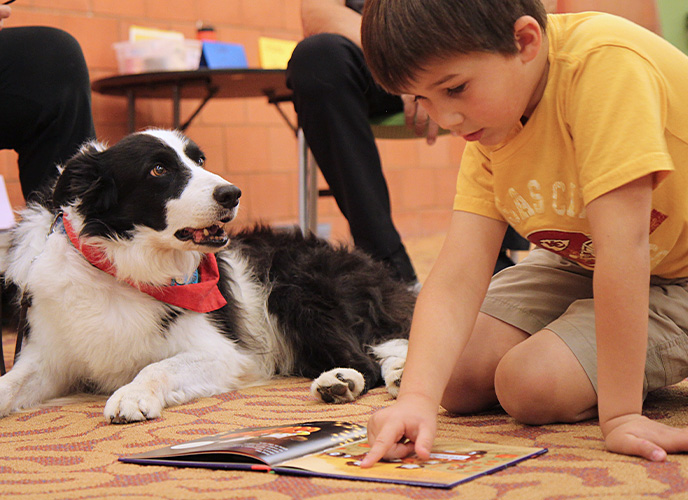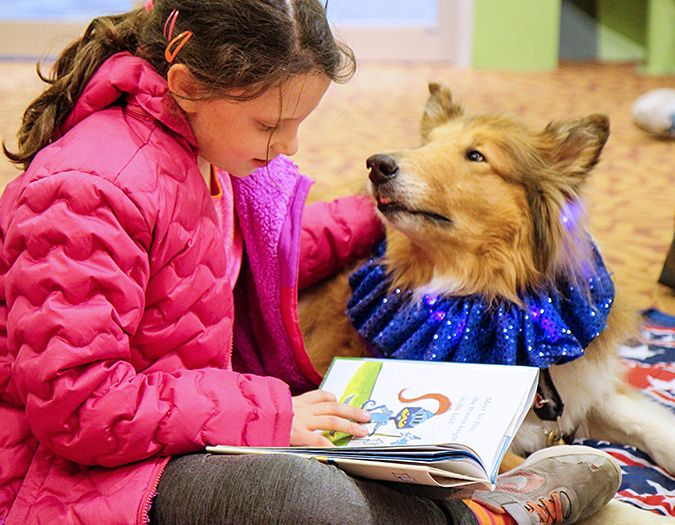 We’ve all heard the phrase “it takes a village to raise a child,” but did you know that village works better if it includes Fido and Fluffy? Whether pets live in your house or at the neighbor’s, research shows that interaction with dogs, cats, hamsters,horses, birds and other animals may help children learn in a number of ways.
We’ve all heard the phrase “it takes a village to raise a child,” but did you know that village works better if it includes Fido and Fluffy? Whether pets live in your house or at the neighbor’s, research shows that interaction with dogs, cats, hamsters,horses, birds and other animals may help children learn in a number of ways.
Struggling or reluctant readers may lack the confidence to read in front of their classmates. They may worry that they will be judged and their self esteem may suffer when they compare themselves to fellow students. Reading to an animal can erase those barriers and help build a child’s confidence, motivation and fluency. The animal doesn’t mind if a word is mispronounced or the story progresses slowly as the child reads along. This non-judgmental audience encourages the child to read more.
If you have a pet, encourage your child to pick out a book to read, and to find a nice quiet spot for a private story time snuggle. A stuffed animal will also work! You can also bring kids to “Reading to Rover” at the Columbia Public Library or “Reading to Rex” at the Southern Boone County Public Library. “There is nothing like having a non-judgemental listener as you speak out loud and practice new skills,” says Sarah Howard, youth and community services manager at the Daniel Boone Regional Library. “Rover” and “Rex” events host certified therapy dogs under the oversight of their owners.
“My daughter, Olivia age 7 (a first-grader), is a regular participant at ‘Reading to Rover.’ We come every month and usually stay the entire two hours! This program has meant so much to her and our family. Olivia is rather shy and was not a confident reader, but that all changed when we started coming to read to the dogs last year! She’s truly like ‘Madeline Finn & the Library Dog’! She’s found her voice and confidence and LOVES reading! Thank you!”
— Laura, Library Patron
Growing up isn’t all about book learning. Children also need to learn how to interact with others and animals can improve a child’s social skills, behavior management and sensory skills, too. When children interact with animals, they may see them as friends and engage them in conversation. The child may want to make the pet feel happy and cared for, and understand that they need to be kind.
 Researchers believe interacting with animals can benefit those with autism and ADHD better succeed in school and are doing further studies to more thoroughly evaluate how it might help. Preliminary data review indicates improved self control and lessening of anxiety.
Researchers believe interacting with animals can benefit those with autism and ADHD better succeed in school and are doing further studies to more thoroughly evaluate how it might help. Preliminary data review indicates improved self control and lessening of anxiety.
Many kids’ faces light up when they see animals at the zoo, dogs at the park or their own pet running up to greet them when they get home. This natural love of animals may lead to a wonderful, joyful way for your kids to be a better reader and a better human being.
Sources for this article:
- “Companion Animals and Child/Adolescent Development: A Systematic Review of the Evidence,” Rebecca Purewal, Robert Christley, Katarzyna Kordas, Carol Joinson, Kerstin Meints, Nancy Gee and Carri Westgarth, International Journal of Environmental Research and Public Health, March 2017.
- “How Kids Can Learn From Pets,” Scholastic Parents, accessed October 2, 2024.
- “How Reading Aloud to Animals Can Boost Kids’ Literacy Skills,” by Jodie Rodriguez, December 14, 2017, Scholastic Parents Raise a Reader Blog.
- “The Power of Pets Health Benefits of Human-Animal Interactions,” NIH News in Health, February 2018.
